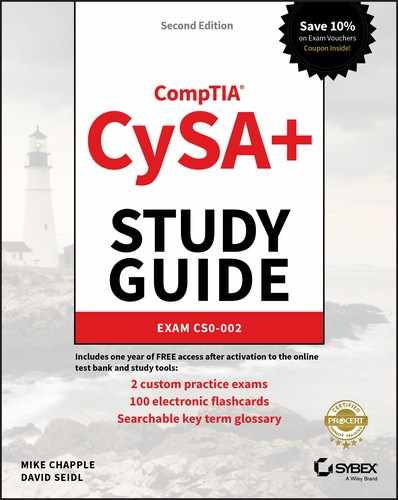Book Description
This updated study guide by two security experts will help you prepare for the CompTIA CySA+ certification exam. Position yourself for success with coverage of crucial security topics!
Where can you find 100% coverage of the revised CompTIA Cybersecurity Analyst+ (CySA+) exam objectives? It’s all in the CompTIA CySA+ Study Guide Exam CS0-002, Second Edition! This guide provides clear and concise information on crucial security topics. You’ll be able to gain insight from practical, real-world examples, plus chapter reviews and exam highlights. Turn to this comprehensive resource to gain authoritative coverage of a range of security subject areas.
- Review threat and vulnerability management topics
- Expand your knowledge of software and systems security
- Gain greater understanding of security operations and monitoring
- Study incident response information
- Get guidance on compliance and assessment
The CompTIA CySA+ Study Guide, Second Edition connects you to useful study tools that help you prepare for the exam. Gain confidence by using its interactive online test bank with hundreds of bonus practice questions, electronic flashcards, and a searchable glossary of key cybersecurity terms. You also get access to hands-on labs and have the opportunity to create a cybersecurity toolkit.
Leading security experts, Mike Chapple and David Seidl, wrote this valuable guide to help you prepare to be CompTIA Security+ certified. If you’re an IT professional who has earned your CompTIA Security+ certification, success on the CySA+ (Cybersecurity Analyst) exam stands as an impressive addition to your professional credentials. Preparing and taking the CS0-002exam can also help you plan for advanced certifications, such as the CompTIA Advanced Security Practitioner (CASP+).
Table of Contents
- Cover
- Acknowledgments
- About the Authors
- About the Technical Editor
- Introduction
- Chapter 1: Today's Cybersecurity Analyst
- Chapter 2: Using Threat Intelligence
- Chapter 3: Reconnaissance and Intelligence Gathering
- Chapter 4: Designing a Vulnerability Management Program
- Chapter 5: Analyzing Vulnerability Scans
- Chapter 6: Cloud Security
- Chapter 7: Infrastructure Security and Controls
- Chapter 8: Identity and Access Management Security
- Chapter 9: Software and Hardware Development Security
- Chapter 10: Security Operations and Monitoring
- Chapter 11: Building an Incident Response Program
- Chapter 12: Analyzing Indicators of Compromise
- Chapter 13: Performing Forensic Analysis and Techniques
- Chapter 14: Containment, Eradication, and Recovery
- Chapter 15: Risk Management
- Chapter 16: Policy and Compliance
- Appendix A: Practice Exam
- Appendix B: Answers to Review Questions and Practice Exam
- Chapter 1: Today's Cybersecurity Analyst
- Chapter 2: Using Threat Intelligence
- Chapter 3: Reconnaissance and Intelligence Gathering
- Chapter 4: Designing a Vulnerability Management Program
- Chapter 5: Analyzing Vulnerability Scans
- Chapter 6: Cloud Security
- Chapter 7: Infrastructure Security and Controls
- Chapter 8: Identity and Access Management Security
- Chapter 9: Software and Hardware Development Security
- Chapter 10: Security Operations and Monitoring
- Chapter 11: Building an Incident Response Program
- Chapter 12: Analyzing Indicators of Compromise
- Chapter 13: Performing Forensic Analysis and Techniques
- Chapter 14: Containment, Eradication, and Recovery
- Chapter 15: Risk Management
- Chapter 16: Policy and Compliance
- Practice Exam Answers
- Appendix C: Answers to Lab Exercises
- Chapter 1: Today's Cybersecurity Analyst
- Chapter 2: Using Threat Intelligence
- Chapter 3: Reconnaissance and Intelligence Gathering
- Chapter 5: Analyzing Vulnerability Scans
- Chapter 7: Infrastructure Security and Controls
- Chapter 8: Identity and Access Management Security
- Chapter 9: Software and Hardware Development Security
- Chapter 10: Security Operations and Monitoring
- Chapter 11: Building an Incident Response Program
- Chapter 12: Analyzing Indicators of Compromise
- Chapter 13: Performing Forensic Analysis and Techniques
- Chapter 14: Containment, Eradication, and Recovery
- Chapter 15: Risk Management
- Chapter 16: Policy and Compliance
- Index
- End User License Agreement
